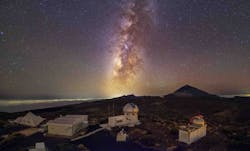LED and SSL technology must evolve in observatory-friendly manner (MAGAZINE)
Exploring the potential – and literal – impact of near-Earth objects and the more serious purposes of observatories, Maury Wright considers the basis of dark-sky-friendly lighting design practices.
I’ve come to realize that the debate over dark skies and LED-based outdoor lighting is far more complex than I first realized. I still think there has been hyperbole aplenty on both sides of the debate. And safety should be a guiding light in the matter. But a UFO has convinced me that the LED and solid-state lighting (SSL) sectors must ensure that outdoor SSL doesn’t impact our observatories, and that will require action at the LED component, SSL system, and lighting design/specification levels. Indeed, Oumuamua will make you rethink the notion of safety.
In this issue, you will find an article that I wrote about presentations made at the IES (Illuminating Engineering Society) Street & Area Lighting Conference in October. One of the presentations covered came from astronomer Richard Wainscoat of the University of Hawaii. Wainscoat discussed how blue-rich spectral energy impacts astronomy and the need to protect observatories because of a critical mission detecting near-Earth objects that could devastate Earth should one impact our planet.
What I did not cover in detail in the article was Wainscoat’s description of a UFO that passed through our solar system in Oct. 2017. That object was discovered by the Pan-STARRS1 telescope in Hawaii and led scientists to conclude it was a new type of interstellar object. The object was named Oumuamua (a Hawaiian word meaning a messenger that reaches out from the distant past), and it is the only object observed to transit our solar system coming from somewhere else and accelerating out of our system at nearly 200,000 MPH. Fortunately, telescopes caught the object during its three-day transit.
As we approached press time for this issue, researchers from the Harvard Smithsonian Center for Astrophysics published a paper dismissing the possibility that the object was a comet or an asteroid, stating a belief that it likely had an artificial origin. The researchers suggested it could have been a functional alien craft sent to observe Earth or a no-longer-operational part of such a craft.
Now, I’m not going to offer an opinion as to what Oumuamua was or is. But I am convinced we need observatories to have an efficient view of the night sky. At the same time, we owe Earth the favor of sustainability and energy efficiency. And we must protect the safety of citizens outdoors at night.
Much of the work can come in SSL system design, lighting design, and implementation. There is no excuse for direct uplight going forward. Fortunately, light reflected off surfaces such as streets is less of an issue for observatories, because much of that energy goes straight up and exits our atmosphere rather than being scattered.
The real concern is what to do about spectra. In the aforementioned article, I also wrote about a US Department of Energy (DOE) Pacific Northwest National Laboratory (PNNL) tool designed to estimate the impact of light sources on sky glow. PNNL research suggests poorly-designed luminaires and lights that operate too brightly are far worse offenders than is blue spectral energy.
Still, I came away thinking about alternative approaches in LEDs and the possibility that we need to again consider tunable outdoor lighting that might transition away from blue energy once traffic slows for the long night.
There’s nothing like a real UFO to get you thinking.
Maury Wright
EDITOR
[email protected]

Maury Wright | Editor in Chief
Maury Wright is an electronics engineer turned technology journalist, who has focused specifically on the LED & Lighting industry for the past decade. Wright first wrote for LEDs Magazine as a contractor in 2010, and took over as Editor-in-Chief in 2012. He has broad experience in technology areas ranging from microprocessors to digital media to wireless networks that he gained over 30 years in the trade press. Wright has experience running global editorial operations, such as during his tenure as worldwide editorial director of EDN Magazine, and has been instrumental in launching publication websites going back to the earliest days of the Internet. Wright has won numerous industry awards, including multiple ASBPE national awards for B2B journalism excellence, and has received finalist recognition for LEDs Magazine in the FOLIO Eddie Awards. He received a BS in electrical engineering from Auburn University.






